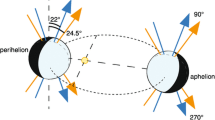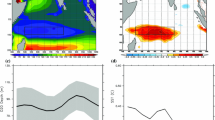Abstract.
The climate of the last glacial maximum (LGM) is simulated with a coupled climate model. The simulated climate undergoes a rapid adjustment during the first several decades after imposition of LGM boundary conditions, as described in Part 1, and then evolves toward equilibrium over 900 model years. The climate simulated by the coupled model at this period is compared with observationally-based LGM reconstructions and with LGM results obtained with an atmosphere-mixed layer (slab) ocean version of the model in order to investigate the role of ocean dynamics in the LGM climate. Global mean surface air temperature and sea surface temperature (SST) decrease by about 10 °C and 5.6 °C in the coupled model which includes ocean dynamics, compared to decreases of 6.3 and 3.8 °C in slab ocean case. The coupled model simulates a cooling of about 6.5 °C over the tropics, which is larger than that of the CLIMAP reconstruction (1.7 °C) and larger than that of the slab ocean simulation (3.3 °C), but which is in reasonable agreement with some recent proxy estimates. The ocean dynamics of the coupled model captures features found in the CLIMAP reconstructions such as a relative maximum of ocean cooling over the tropical Pacific associated with a mean La Niña-like response and lead to a more realistic SST pattern than in the slab model case. The reduction in global mean precipitation simulated in the coupled model is larger (15%) than that simulated with the slab ocean model (∼10%) in conjunction with the enhanced cooling. Some regions, such as the USA and the Mediterranean region, experience increased precipitation in accord with proxy paleoclimate evidence. The overall much drier climate over the ocean leads to higher sea surface salinity (SSS) in most ocean basins except for the North Atlantic where SSS is considerably lower due to an increase in the supply of fresh water from the Mississippi and Amazon rivers and presumably a decrease in salt transport by the weakened North Atlantic overturning circulation. The North Atlantic overturning stream function weakens to less than half of the control run value. The overturning is limited to a shallower depth (less than 1000 m) and its outflow is confined to the Northern Hemisphere. In the Southern Ocean, convection is much stronger than in the control run leading to a stronger overturning stream function associated with enhanced Antarctic Bottom Water formation. As a result, Southern Ocean water masses fill the entire deep ocean. The Antarctic Circumpolar Current (ACC) transport through the Drake Passage increases by about 25%. The ACC transport, despite weaker zonal winds, is enhanced due to changes in bottom pressure torque. The weakening of the overturning circulation in the North Atlantic and the accompanying 30% decrease in the poleward ocean heat transport contrasts with the strengthening of the overturning circulation in the Southern Ocean and a 40% increase in heat transport. As a result, sea ice coverage and thickness are affected in opposite senses in the two hemispheres. The LGM climate simulated by the coupled model is in reasonable agreement with paleoclimate proxy evidence. The dynamical response of the ocean in the coupled model plays an important role in determining the simulated, and undoubtedly, the actual, LGM climate.
Similar content being viewed by others
Author information
Authors and Affiliations
Additional information
Electronic Publication
Rights and permissions
About this article
Cite this article
Kim, .SJ., Flato, .G. & Boer, .G. A coupled climate model simulation of the Last Glacial Maximum, Part 2: approach to equilibrium. Climate Dynamics 20, 635–661 (2003). https://doi.org/10.1007/s00382-002-0292-2
Received:
Accepted:
Issue Date:
DOI: https://doi.org/10.1007/s00382-002-0292-2




